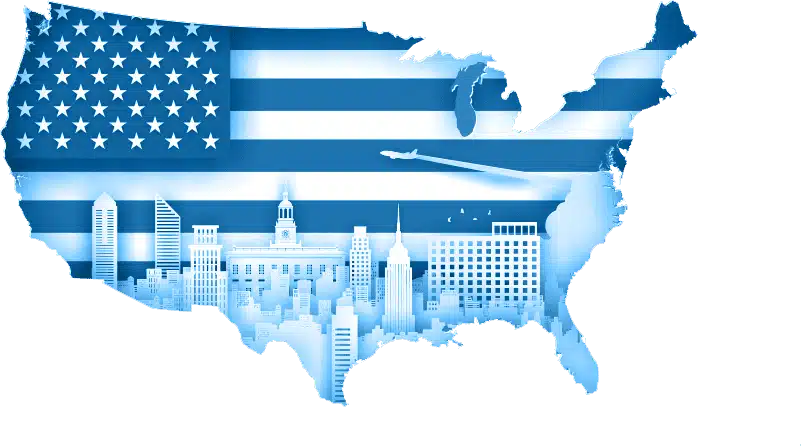Federal Reserve

- What is the U.S. Federal Reserve?
- How does the U.S. Federal Reserve work?
- The Structure of the U.S. Federal Reserve
- The Functions of the U.S. Federal Reserve
- The Fed in Fundamental Analysis
- How to Trade with the Fed Interest Rate Decisions?
A few centuries ago, when waves of immigrants flocked to the American continent from all around the world, every individual dreamed of realising their potential in the land of opportunity, some might call it the American Dream. These hard-working people worked with a collective resolution to succeed no matter what came their way.
Eventually, their striving for achievement bore its fruits and turned the U.S. economy into an engine, which now thrives and grows under all adversities, be it an economic depression or a war. The mastermind of this system, the U.S. Federal Reserve, certainly deserves the strongest credit in managing a continent-wide economy.
See a trading opportunity? Open an account now!
What is the U.S. Federal Reserve?
The U.S. Federal Reserve System (FRS), also called the Federal Reserve or simply the Fed is the Central Bank of the United States of America. It was established to provide a flexible, secure, and steady system for national monetary and financial affairs.
The Federal Reserve Act was ratified by the U.S. Congress on December 23, 1913, and signed into law by President Woodrow Wilson. It approved the setup of 12 Federal Reserve Banks, which are in Atlanta, Boston, Chicago, Cleveland, Dallas, Kansas City, Minneapolis, New York, Philadelphia, Richmond, San Francisco, and St. Louis.
The Fed is often considered as the most powerful financial institution in the world. It administrates the largest economy in the world – the U.S. economy; governs the value of the global reserve currency – the U.S. Dollar; and regulates the world’s top two stock markets – the New York Stock Exchange (NYSE) and the NASDAQ (NSDQ).
How does the U.S. Federal Reserve work?
The U.S. Federal Reserve works and makes decisions independently from the U.S. government and the President. However, its operations are overseen by the U.S. Congress and expected to be in congruence with the national economic policy. The Fed’s main responsibilities are:
- Issuing the U.S. Dollar, governing its value, and setting the Federal Reserve interest rate.
- Conducting the monetary policy for maximum employment, price stability and interest rates.
- Supervising the Federal Reserve Banks and maintaining the stability of the financial system.
- Regulating the banks, financial institutions, and financial markets to protect consumers.
- Providing financial services to depository institutions, the government, and foreign official institutions.
The Structure of the U.S. Federal Reserve
The structure of the U.S. Federal Reserve is comprised of the Federal Reserve Board, the Federal Reserve Banks, and the Federal Open Market Committee (FOMC).
The Federal Reserve Board (FRB), also known as the Board of Governors, is the governing committee whose seven members are nominated by the President of the United States and confirmed by the US Senate. The primary functions of the governors are to implement the monetary policy, set the Fed interest rate, and to engage in the operations of the Fed.
The Federal Reserve Banks manage the monetary affairs and regulate commercial banks in their own judicial districts. They have semi-autonomous power to create regional monetary policies in accordance with the local economic conditions and the federal monetary policy. There are twelve decentralised Fed banks, and each is incorporated separately with a nine-member board.
The Federal Open Market Committee mandates open market operations and exercises economic interventions as needed. The 19-member committee includes the Board of Governors and the regional Fed Presidents. In the decision-making process, all governors and the President of the New York Fed have full voting rights, while only four of the remaining eleven regional Reserve Bank presidents are entitled to vote in one-year rotations. Full consensus is required to decree a decision.
The Functions of the U.S. Federal Reserve
The functions of the U.S. Federal Reserve revolve around the purposes of maximising the national employment rate, stabilising the prices, and moderating the long-term interest rates.
The Board of Governors sets the monetary policy in alignment with the national economic policy and the U.S. Government’s fiscal policy. It uses Gross Domestic Product (GDP), inflation, and unemployment rate figures to gauge the current conditions of the U.S. economy and predict potential pitfalls.
When the economic indicators are underperforming, the Board of Governors and the FOMC work in conjunction to intervene in the economy.
They use interest rates, open market operations, and minimum reserve requirements to modify the money supply in circulation and navigate the economy towards the monetary policy goals.
The Board of Governors sets the minimum reserve requirements of the Federal Reserve Banks and other commercial banks in the financial system. It requires all banks to keep a certain amount of U.S. Dollars in their reserves to be prepared against possible systemic risks.
Moreover, as the lender of last resort, the Board decides the interest rate applied when the Fed lends to other banks in the country, also known as the Discount Rate.
The FOMC conducts, oversees, and sets policy for open market operations, which is the primary tool of the Fed to steer the economy. It sells and buys back government securities to increase or decrease the cash in the economy.
Furthermore, the Fed prefers the financial institutions to loan from each other before applying the central bank. The FOMC regulates the interbank interest rates with the Fed Funds Rate, which is typically lower than the Discount Rate to encourage interbank loans.
The U.S. Federal Reserve in Fundamental Analysis
The operational purpose of the U.S. Federal Reserve is to navigate the economy towards monetary policy goals. The bank strives to achieve its inflation and employment targets mainly through modifying the money supply in circulation, which is tasked to the Federal Open Market Committee.
The FOMC central bank meetings occur eight times a year (every six weeks) to set the Fed Funds Rate for interbank loans and decide on open market operations. Any change in the Fed rates alters the currency strength of the U.S. Dollar, whereby increasing or decreasing its accessibility for businesses and consumers.
The Fed Interest Rate Hikes
When the U.S. economy is expanding rapidly, the inflation in consumer prices must be balanced with increased income and wages. However, the overall inflation can reach a level at which the companies can’t afford expansive investments and high salaries simultaneously, leading to massive unemployment.
To prevent an economic stalemate, the FOMC can raise the Fed Funds Rate. The interbank loans will be costlier, and the banks will reflect the increased expenses on their financial products. Expensive loans will discourage companies and consumers from borrowing and spending, reducing the demand in the economy in a controlled fashion.
Fed rate hikes add value to the U.S. Dollar and help USD rise against other currencies. On the other hand, reduced business activity would decrease the profitability of the companies. As a result, the investors would withdraw their capital from the U.S. stocks and indices, causing them to fall, and tie it to interest-based investments such as the U.S. Treasury Notes and bonds would have higher yields.
The Fed Interest Rate Cuts
In the opposite scenario, when the U.S. economy is in the grip of recession, the FOMC can decrease the Fed Funds Rate to stimulate economic activity. Low interbank borrowing costs would allow the banks to offer loans with more advantageous commission structures.
Consequently, American companies would be encouraged to expand their businesses with new investments and larger workforces. Increased employment and steady income would enhance consumer spending, and companies would enjoy higher corporate profits.
Fed rate cuts cause the U.S. Dollar to lose value in general and in the currency pairs. Interest-based investments become less attractive to investors.
As such, they would redirect their investments to the stock markets, where the companies are entertaining higher profit potentials and might offer larger dividend payments.
How to Trade with the U.S. Federal Reserve Interest Rate Decisions?
As the governor of the world’s top economic units, the U.S. Federal Reserve attracts one of the highest levels of attention in the financial markets.
The FOMC interest rate decisions have an enormous impact on the USD pairs, American equities listed in the NYSE and the NASDAQ, commodities like Gold and WTI Crude Oil traded in the New York Mercantile Exchange (NYMEX), and the U.S. Treasury Notes. Hence, each of the eight Fed interest rate meetings in the year creates numerous opportunities for news trading strategies.
Naturally, the markets wait for the conclusion of each Fed meeting on pins and needles. The FOMC rate decisions are published with an official statement and cause significant market turmoil.
The Fed Chair holds a press conference to explain their decisions and economic outlook. Additionally, the Fed meeting minutes are released, which contains the details of the discussions made by the FOMC members.
The price actions in the market after the Fed meetings usually depend on the market sentiment. If the analysts forecast an interest rate hike and the Fed delivers it, the USD would gain value across the board and send the stocks, indices, and commodities southwards.
Similarly, if the Fed cuts the interest rates as expected, the USD will lose value, and other American assets would rise in general. While these are the most common outcomes, different market behaviours can be observed in extreme economic conditions like trade wars, recessions, or pandemics.
In regular circumstances, the FOMC central bank meetings are arguably the most volatility-evoking events in the markets. However, the price fluctuations can further intensify if the Fed makes an unexpected decision or signals one for the future. Investors and analysts around the world inspect the Fed meeting minutes specifically to find clues regarding such decisions and take positions accordingly.
Disclaimer – While due diligence, care and research have been undertaken to compile the above content, it remains an informational and educational piece only. None of the content provided constitutes any form of trade or investment advice or recommendation and should not be construed as such.
Why Trade the U.S. Federal Reserve Events with Friedberg Direct, Powered by AvaTrade Technology
The U.S. Fed central bank meetings as one of the most influential market events globally, holds special importance for the financial markets. The FOMC interest rate decisions are made only eight times a year, and often cause extreme volatility with numerous high-return & high-risk opportunities. Monitoring the economic indicators used by the Fed, accompanied by our state-of-the-art trading platforms, you can create a wise trading strategy for the Fed meetings.
- Next Fed Meeting: Check the economic calendar to see the scheduled Fed meetings and start preparing for the closest FOMC rate decision.
- The World’s Top Assets: Trade Fed events with the most popular assets like major and minor USD currency pairs, CFDs on USD-traded commodities, CFDs on U.S. stocks like Amazon and indices like S&P500.
- Adapt to Any Decision: Thanks to our CFD trading offering, you can capitalise on any market reaction with Buy and Sell positions, without having to physically own the assets.
The immense global influence of the United States of America stems from its powerful domestic economy. The conductor of this locomotive, the U.S. Federal Reserve, has proven its success repeatedly considering that the U.S. economy tops the charts in all kinds of economic activities. Now that you know how the Fed’s decision makers operate and how their actions affect the U.S. markets, capitalise on your knowledge with our great trading conditions and start trading with confidence!
See a trading opportunity? Open an account now!







